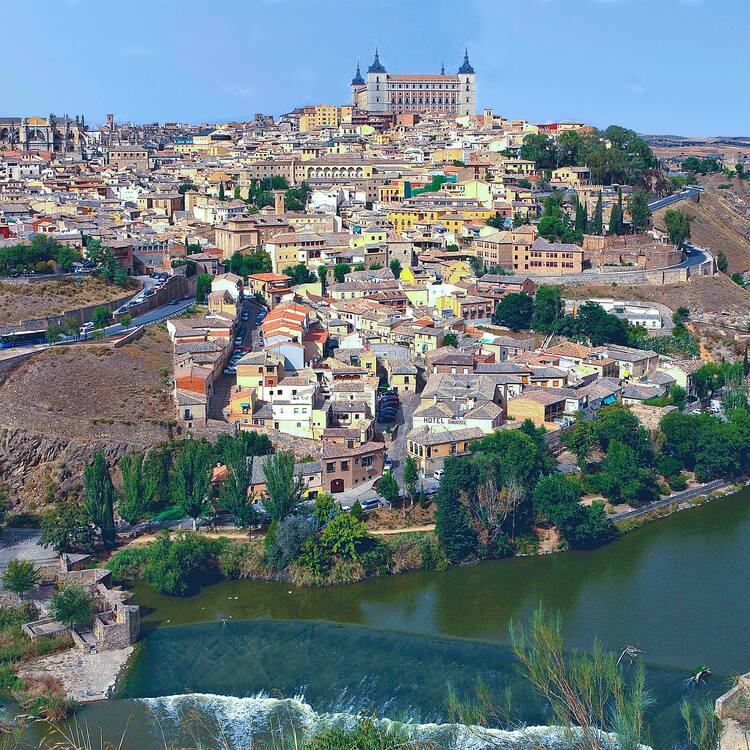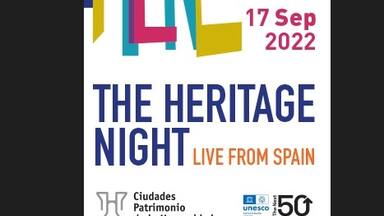Historic City of Toledo
Historic City of Toledo
Successively a Roman municipium, the capital of the Visigothic Kingdom, a fortress of the Emirate of Cordoba, an outpost of the Christian kingdoms fighting the Moors and, in the 16th century, the temporary seat of supreme power under Charles V, Toledo is the repository of more than 2,000 years of history. Its masterpieces are the product of heterogeneous civilizations in an environment where the existence of three major religions – Judaism, Christianity and Islam – was a major factor.
Description is available under license CC-BY-SA IGO 3.0
Ville historique de Tolède
Successivement municipe romain, capitale du royaume wisigoth, place forte de l'émirat de Cordoue, avant-poste des royaumes chrétiens en lutte contre les Maures et, au XVIe siècle, siège temporaire du pouvoir suprême sous Charles Quint, Tolède est la gardienne de plus de deux millénaires d'histoire. Ses chefs-d'œuvre proviennent de diverses civilisations dans un environnement où l'existence de trois grandes religions – le judaïsme, le christianisme et l'islam – était un élément essentiel.
Description is available under license CC-BY-SA IGO 3.0
مدينة طليطلة التاريخيّة
كانت هذه المدينة على التوالي تابعة للرومان، وعاصمة مملكة شعب القوط وموقعاً مهماً من مواقع إمارة قرطبة وفي طليعة الممالك المسيحيّة في قتالها ضد العرب وفي القرن السادس عشر أصبحت مقرّ السلطة المؤقتة تحت سيطرة شارل كان وهي بالتالي مؤتمنة على أكثر من ألفي عام من التاريخ. تحفها الفنيّة تتقاطر من حضارات عدّة في بيئة كان فيها وجود الديانات الكبرى الثلاث اليهوديّة والمسيحيّة والإسلام عنصراً أساسيّاً.
source: UNESCO/CPE
Description is available under license CC-BY-SA IGO 3.0
历史名城托莱多
托莱多城的历史长达两千多年,曾先后是罗马帝国统治下的城市,西哥特王国的首都,科尔多瓦酋长国的要塞,基督教国家和摩尔人战斗的前线,以及公元16世纪查尔斯五世统治时期的最高权力临时所在地。托莱多城与众不同之处在于在同一种环境中孕育了不同的文明,而产生多种文明的主要原因是三种主要宗教——犹太教、基督教和伊斯兰教在这块土地上共同存在。
source: UNESCO/CPE
Description is available under license CC-BY-SA IGO 3.0
Исторический центр города Толедо
Бывший последовательно древнеримским поселением, столицей королевства вестготов, крепостью Кордовского эмирата, форпостом христианских королевств в борьбе с маврами, а в XVI в. – временной резиденцией великой державы Карла V, Толедо является хранилищем свидетельств более чем двухтысячелетней истории. Его шедевры – это синтез самых разных культур, развивавшихся под воздействием трех мировых религий – иудаизма, христианства и ислама.
source: UNESCO/CPE
Description is available under license CC-BY-SA IGO 3.0
Ciudad histórica de Toledo
Depositaria de más de dos milenios de historia, Toledo fue sucesivamente municipio romano, capital del reino visigodo, plaza fuerte del emirato de Córdoba y puesto de mando avanzado de los reinos cristianos en su lucha contra los musulmanes. En el siglo XVI fue la sede temporal del poder supremo, bajo el reinado del emperador Carlos V. Sus monumentos son obras maestras de distintas civilizaciones, creadas en un contexto en el que la presencia de tres grandes religiones –judaísmo, cristianismo e islamismo– constituyó un factor esencial.
source: UNESCO/CPE
Description is available under license CC-BY-SA IGO 3.0
古都トレド
source: NFUAJ
Historische stad Toledo
Source: unesco.nl
Outstanding Universal Value
Brief synthesis
Toledo is a city located in central Spain, 70 km south of Madrid. Built upon a steep rock skirted by the Tagus River, the Historic City of Toledo still retains the essential features of an incomparable cityscape. The Historic City of Toledo, shaped by twenty centuries of history, encompasses about 260 ha, and has preserved a remarkable historical heritage and consolidated cultural tradition. It was one of the former capitals of the Spanish Empire and place of coexistence of Christian, Jewish and Muslim cultures during the Middle Ages. Successively, a Roman municipium, the capital of the Visigothic kingdom, a fortress of the Umayyad realms of Córdoba, an outpost of the Christian kingdoms against the Almoravid and Almohad empires, and in early modern period, between 1519 and 1561, the temporary seat of supreme power under Charles V.
Despite the irreversible economic and political decadence of Toledo after 1561, when Phillip II eventually chose Madrid as his capital, a great number of architectural masterpieces from different periods were preserved. This singular array of historic buildings expresses both the original, highly characteristic beauty and the paradoxical syncretic hybrid forms of the Mudejar style, which sprang from the contact of heterogeneous civilisations in an environment where, for a long time, the existence of three major religions: Judaism, Christianity, and Islam, was a leading feature.
The Historic City of Toledo is linked to deep popular traditions and continues to be the repository of more than 2,000 years of history. It is an exceptional testimony of several past civilizations: Rome, with vestiges of the circus, the bridge over the Tagus River, the aqueduct and the sewers, the Visigoths, with the remains of Royal Palatine complex, king Wamba´s walls, preserved early medieval churches, the Vega Baja site and the artifacts conserved in the Santa Cruz, and Visigothic Councils and Culture Museums.
During the Medieval and Muslim periods many monuments were built: the city wall and other fortified buildings (San Servando Castle and the Alcázar), hammams, mosques, a few houses, and urban palaces. The Umayyad civilisation built great many Islamic art monuments, the pillars of the destroyed Puente de la Cava, Puerta Vieja de Bisagra gate, Las Tornerías Mosque, Bib Mardum Mosque (a private oratory completed in 999), Hammams in the calle del Ángel and calle Pozo Amargo, etc. After the 1085 Christian conquest, remarkable Jewish religious monuments, such as Santa María la Blanca Synagogue and El Tránsito Synagogue, were built at the same time as mudejar churches, either on the very location of earlier foundations (the Cathedral, founded in the 6th century by Saint Eugene, which was converted into a mosque during the Muslim period), or ex nihilo (San Román, Santiago, San Pedro Mártir, etc.). Synagogues, mosques, and churches jostle in the narrow streets of Toledo, which is characterized by the mixture of artistic styles. All of that made Toledo the “city of the three cultures”. This was one of the Toledo's most splendid periods when, among other relevant events, Toledo’s School of Translators was founded.
Criterion (i): The city of Toledo in its entirety represents a unique artistic achievement and an uninterrupted succession of remarkable achievements, from the Visigothic churches to the Baroque ensembles of the early 18th century.
Criterion (ii): Toledo exerted considerable influence, both during the Visigoth period, when it was the capital of a kingdom which stretched all the way to the Narbonnese region, and during the Renaissance, when it became one of the most important artistic centres in Spain.
Criterion (iii): Toledo bears exceptional testimony of several past civilisations and maintains remarkable architectural features from the Roman, the Visigoths, the Andalusian and Jewish occupation as well as a broad spectrum of structures from the medieval period.
Criterion (iv): Toledo retains a series of outstanding examples of 15th- and 16th-century constructions: the church of San Juan de los Reyes and the Cathedral, San Juan Bautista and Santa Cruz hospitals, the Puerta Nueva de Bisagra, etc. Each of these monuments is a perfect example of a particular type of architecture of the Spanish golden age, whether religious, hospital or military. Moreover, Toledo witnessed the emergence, starting in the Middle Ages, of a Mudejar style which combined the structural and decorative elements of Visigoth and Islamic art, adapting them thereafter into successive styles, represented in buildings such as Santiago del Arrabal (13th century), the Moorish Workshop and Puerta del Sol gate (14th century), the wainscot of Santa Cruz Hospital and the chapter house of the Cathedral (15th and 16th centuries), etc.
Integrity
The property contains all the necessary elements to convey its Outstanding Universal Value. The remarkable cityscape has been largely preserved and material integrity and visual qualities have been maintained through conservation and restoration works as well as with the implementation of rehabilitation policies. Impacts derived from decay processes are largely controlled through sustained maintenance of pre-existing structures and improvement of residential and commercial use. Interventions on archaeological or historic buildings meet international standards and are based on complete and detailed documentation.
Authenticity
The conservation strategies, restoration and rehabilitation works have sought to respect the conditions of authenticity at the property. The Historic City of Toledo has largely retained its form and design and location and setting have been preserved. The city is still linked to deep popular traditions and their authenticity is supported by the preservation of religious festivals and celebrations, such as the procession of the Corpus Christi, where efforts are placed in maintaining tradition and cultural continuity. Similarly, the continued use of churches and other monuments support the authenticity of the property.
Protection and management requirements
The legislative and protective framework for the property includes laws and municipal ordinances: The Special Plan for Toledo’s Historic Quarter (1997); the Spanish Historical Heritage (Protection), the Castilla-La Mancha Cultural Heritage (Protection) and the Territorial Planning and Urban Planning Activity in Castilla-La Mancha.
In terms of management arrangements, there are several different administrative systems organised under Special Plan commissions. These commissions are annexed to the Town Hall of Toledo, and to the Department of Culture of the Autonomous Community of Castilla-La Mancha, the latter being responsible for heritage protection issues. There are currently two protection commissions, composed of representatives of the Autonomous Community and the Town Hall, responsible for the conservation and restoration works implemented.
The Consortium for the City of Toledo is also part of the management system and, with the consent of the three administrations that compose it, is responsible for implementing rehabilitation and restoration initiatives within the monumental ensemble. It is worth noting that the Autonomous Community has competence over heritage protection policies and archaeological protection and management. The Ministry of Culture is responsible for state-owned buildings while the Municipality of Toledo is in charge of urban planning issues.
Actions at the property are coordinated through the Special Plan for Toledo’s Historic Quarter, which should be supplemented with a traffic ordinance to regulate traffic and parking. In order to protect the visual perspectives of the historical complex and the harmony of the landscape, a special regime is established for areas surrounding the property, including the plain of the Tagus River, the Cigarrales and the mountain.
Although great progress has been made in the conservation and management of the property, additional efforts are still necessary to enhance the regulations for the use of non-traditional construction materials and scale and size of new constructions that can affect the urban landscape. Other actions to enhance its state of conservation include the removal of electricity infrastructure and advertisement that visually alter the property. Consideration also needs to be given to enhance the legal framework specifically in providing subventions or fiscal or tax reduction possibilities for urban sites inscribed on the World Heritage List and for listed buildings to ensure the involvement of the State level in the World Heritage related conservation and protection processes. Finally, on-going threats are derived from tourism pressure, particularly in terms of development, commercial activities in public spaces, and traffic issues, which need to be addressed in a systematic and comprehensive way.
Links
-
Tourism in Castilla-La Mancha - World Heritage
-
Castilla-La Mancha Region - World Heritage Catalogue (in Spanish)
-
Ministry of Culture and Sports (in Spanish)
-
 View photos from OUR PLACE the World Heritage collection
View photos from OUR PLACE the World Heritage collection
-
Municipality of Toledo - World Heritage (in Spanish)
-
Toledo - World Heritage Cities of Spain



